- Clone
- L138D7 (See other available formats)
- Regulatory Status
- RUO
- Other Names
- BLR1, GPCR6, MDR-15
- Isotype
- Rat IgG2b, κ
- Ave. Rating
- Submit a Review
- Product Citations
- publications

-

C57BL/6 mouse splenocytes were stained with CD45R/B220 FITC and biotinylated CXCR5 (clone L138D7, top) or rat IgG2b, κ isotype control (bottom), followed by Sav-PE. -

| Cat # | Size | Price | Quantity Check Availability | Save | ||
|---|---|---|---|---|---|---|
| 145509 | 25 µg | $112 | ||||
| 145510 | 100 µg | $293 | ||||
CD185 is also known as CXCR5. It is the receptor for chemokine CXCL13/BLC, which is chemotactic for B cells. CXCR5 is expressed on B cells and a subset of T cells in the spleen, neuronal tissue, lymph nodes, and bone marrow. It is important for migration of B cells into the B cell follicles of the spleen and Peyer’s patches. Follicular helper T cells (Tfh) also express CXCR5 and the ability of these cells to migrate to the lymph node is modulated by the balanced expression of CCR7 and CXCR5.
Product DetailsProduct Details
- Verified Reactivity
- Mouse
- Antibody Type
- Monoclonal
- Host Species
- Rat
- Immunogen
- mCXCR5-transfected cells
- Formulation
- Phosphate-buffered solution, pH 7.2, containing 0.09% sodium azide.
- Preparation
- The antibody was purified by affinity chromatography and conjugated with biotin under optimal conditions.
- Concentration
- 0.5 mg/ml
- Storage & Handling
- The antibody solution should be stored undiluted between 2°C and 8°C. Do not freeze.
- Application
-
FC - Quality tested
- Recommended Usage
-
Each lot of this antibody is quality control tested by immunofluorescent staining with flow cytometric analysis. For flow cytometric staining, the suggested use of this reagent is ≤0.25 µg per million cells in 100 µl volume. It is recommended that the reagent be titrated for optimal performance for each application.
- Application Notes
-
Clone L138D7 staining works optimally at room temperature or 4°C. Unlike other chemokine receptor antibodies, avoid using L138D7 at 37°C.
- Product Citations
-
- RRID
-
AB_2562125 (BioLegend Cat. No. 145509)
AB_2562126 (BioLegend Cat. No. 145510)
Antigen Details
- Structure
- 42 kD, seven transmembrane protein
- Distribution
-
B cells and a subset of T cells in mouse spleen, Tfh cells, also expressed in lymph node, bone marrow, and brain
- Function
- B cell migration into follicles, possible regulatory role in B cell differentiation and Burkitt's lymphoma
- Ligand/Receptor
- BLC/CXCL13
- Cell Type
- B cells, T cells, Tfh
- Biology Area
- Cell Biology, Immunology, Innate Immunity, Neuroinflammation, Neuroscience
- Molecular Family
- CD Molecules, Cytokine/Chemokine Receptors, GPCR
- Antigen References
-
1. Kaiser E, et al. 1993. Eur. J. Immunol. 23:2532.
2. Forster R, et al. 1994. Cell. Mol. Biol. 40:381.
3. Forster R, et al. 1994. Blood 84:830.
4. Forster R, et al. 1996. Cell 87:1037.
5. Wolf I, et al. 1998. J. Biol. Chem. 273:28831. - Gene ID
- 12145 View all products for this Gene ID
- UniProt
- View information about CD185 on UniProt.org
Related FAQs
- How many biotin molecules are per antibody structure?
- We don't routinely measure the number of biotins with our antibody products but the number of biotin molecules range from 3-6 molecules per antibody.
Other Formats
View All CD185 Reagents Request Custom ConjugationCustomers Also Purchased
Compare Data Across All Formats
This data display is provided for general comparisons between formats.
Your actual data may vary due to variations in samples, target cells, instruments and their settings, staining conditions, and other factors.
If you need assistance with selecting the best format contact our expert technical support team.
-
Purified anti-mouse CD185 (CXCR5)

C57BL/6 mouse splenocytes were stained with purified CXCR5 (... -
PE anti-mouse CD185 (CXCR5)

C57BL/6 mouse splenocytes were stained with CD45R/B220 FITC ... 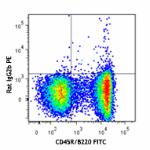
-
APC anti-mouse CD185 (CXCR5)
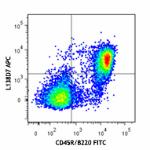
C57BL/6 mouse splenocytes were stained with CD45R/B220 FITC ... 
-
PerCP/Cyanine5.5 anti-mouse CD185 (CXCR5)

C57BL/6 mouse splenocytes were stained with CD45R/B220 FITC ... -
Biotin anti-mouse CD185 (CXCR5)
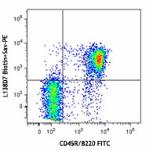
C57BL/6 mouse splenocytes were stained with CD45R/B220 FITC ... 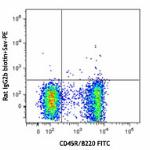
-
Brilliant Violet 421™ anti-mouse CD185 (CXCR5)

C57BL/6 mouse splenocytes were stained with CD45R/B220 FITC ... 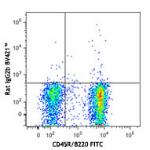
-
Brilliant Violet 605™ anti-mouse CD185 (CXCR5)
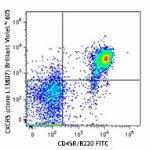
C57BL/6 mouse splenocytes were stained with CD45R/B220 FITC ... 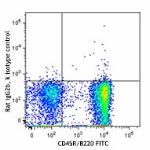
-
PE/Cyanine7 anti-mouse CD185 (CXCR5)

C57BL/6 mouse splenocytes were stained with CD45R/B220 FITC ... -
Brilliant Violet 650™ anti-mouse CD185 (CXCR5)
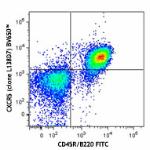
C57BL/6 mouse splenocytes were stained with CD45R/B220 FITC ... 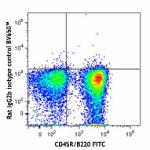
-
FITC anti-mouse CD185 (CXCR5)
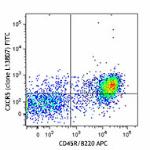
C57BL/6 mouse splenocytes were stained with CD45R/B220 APC a... 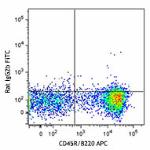
-
PE/Dazzle™ 594 anti-mouse CD185 (CXCR5)

C57BL/6 mouse splenocytes were stained with CD45R/B220 FITC ... -
Brilliant Violet 785™ anti-mouse CD185 (CXCR5)

C57BL/6 mouse splenocytes were stained with CD45R/B220 PE an... 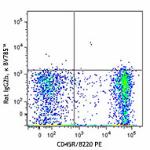
-
APC/Cyanine7 anti-mouse CD185 (CXCR5)

C57BL/6 mouse splenocytes were stained with CD45R/B220 FITC ... -
Brilliant Violet 711™ anti-mouse CD185 (CXCR5)

C57BL/6 mouse splenocytes were stained with CD45R/B220 FITC ... -
Alexa Fluor® 647 anti-mouse CD185 (CXCR5)

C57BL/6 mouse splenocytes were stained with CD45R/B220 PE an... -
APC/Fire™ 750 anti-mouse CD185 (CXCR5)

C57BL/6 mouse splenocytes were stained with CD45R/B220 PE an... -
TotalSeq™-A0846 anti-mouse CD185 (CXCR5)
-
TotalSeq™-C0846 anti-mouse CD185 (CXCR5)
-
TotalSeq™-B0846 anti-mouse CD185 (CXCR5) Antibody
-
Brilliant Violet 750™ anti-mouse CD185 (CXCR5)

C57BL/6 mouse splenocytes were stained with anti-mouse CD45R... -
Spark Red™ 718 anti-mouse CD185 (CXCR5)

C57BL/6 mouse splenocytes were stained with anti-mouse/human... -
APC/Fire™ 810 anti-mouse CD185 (CXCR5)

C57BL/6 mouse splenocytes were stained with anti-mouse/human...
 Login/Register
Login/Register 







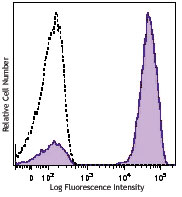
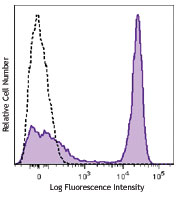
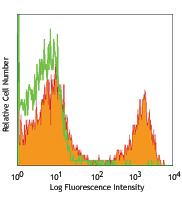
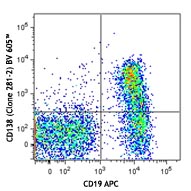



Follow Us